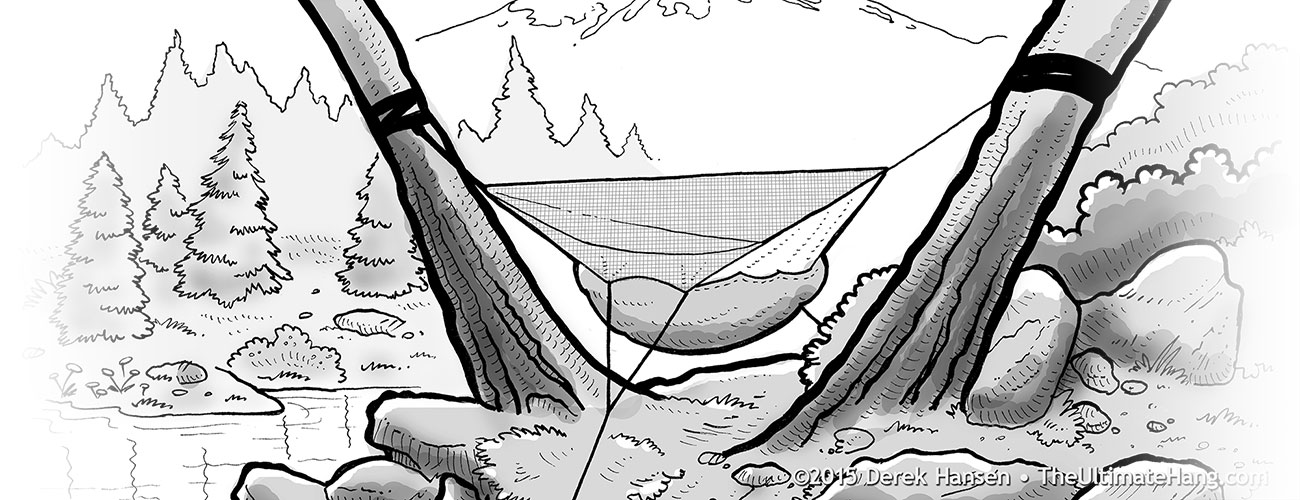The humble hammock has been around for thousands of years, and it is still used today in parts of the world as a primary sleeping accommodation. Yet many people I speak with think hammocks are “uncomfortable,” or it will hurt their back,” or “they’re great for summer lounging only,” or “it’s too easy to fall out.” A lot of these misconceptions come from the modern rope hammocks with their spreader bars and large woven nets. These hammocks are notoriously tippy, due to their high center of gravity and tight pitch. Unfortunately, they’ve given authentic hammocks a bad wrap.
Most camping hammocks are based on the original, authentic Brazilian or Mayan styles of South America with their deep sag, tight weave, and gathered ends.
Here are some quick tips for getting started with hammock camping, including getting that perfect Brazilian hang.
 1. Use webbing straps around trees or other anchor points. One to 1.5 in (2.5 to 3.8 cm) polyester or polypropylene webbing straps help disperse the weight and reduce damage to trees or other objects. Polyester and polypropylene are also low-stretch, so you won’t sag during the night (avoid nylon straps, which stretch).
1. Use webbing straps around trees or other anchor points. One to 1.5 in (2.5 to 3.8 cm) polyester or polypropylene webbing straps help disperse the weight and reduce damage to trees or other objects. Polyester and polypropylene are also low-stretch, so you won’t sag during the night (avoid nylon straps, which stretch).
 1. Angle your hammock suspension (rope) at around 30°. Pitching a hammock too tight between anchor points puts an enormous amount of force on the suspension lines and hammock, leading to potential failure (and discomfort). A tight pitch also raises the center of gravity, making the hammock unsteady. Pitching the hammock at 30° ensures you get a deep sag (tip #2).
1. Angle your hammock suspension (rope) at around 30°. Pitching a hammock too tight between anchor points puts an enormous amount of force on the suspension lines and hammock, leading to potential failure (and discomfort). A tight pitch also raises the center of gravity, making the hammock unsteady. Pitching the hammock at 30° ensures you get a deep sag (tip #2).
2. Get a deep(ish) sag. Like a friendly smile, a hammock should be low in the center and high near the ends. With a deep sag, it is very difficult to accidentally fall out, thanks to the low center of gravity and high fabric walls. A deep sag allows you to lay on the diagonal (tip #3).
3. Lay on the diagonal. A lot of beginners try to sleep in line with the hammock, curving their bodies into a banana shape. I find that this takes a lot of effort, because with a good sag, your feet naturally slide to one side or the other, finding a “pocket” of fabric. By angling your body askew of center, you fall into a ergonomically flat position (it looks a bit like a recumbent bicyclist), where the hammock takes away all the pressure points naturally. The diagonal lay is the key to comfort in a gathered-end hammock.
4. Insulate underneath. Hammocks are a godsend in hot, muggy areas where the extra air circulation makes outdoor camping tolerable. But as temperatures drop below 70°F (21°C), you’ll start to feel the effects of convective heat loss known as Cold Butt Syndrome (CBS). A sleeping pad (closed-cell foam or self-inflating) works great, and some hangers use them year-round. Purpose-built “under quilts” are another popular option for keeping you warm underneath. For hot summer nights, you may only need a thin blanket to regulate your temperature.
5. Guard against flying bugs. When flying bugs (mosquitos, moths, midges, biting flies, etc.) are a problem, you’ll want bug netting to protect you. Some camping hammocks have sewn-in netting, but you can purchase after-market netting too. My Hammock Manufacturer List indicates which retailers sell hammock bug netting.
6. Protect yourself from rain. A basic 8×10 tarp is more than adequate to protect you from rain and wind. You can also find models with extra tie-outs for more pitching options. You can pitch tarps in a variety of styles, including a basic diamond configuration, an “A”-frame, or a fully-enclosed shelter with doors on the ends.
Read More: Pitching options for a 10×10 tarp










Leave a Reply